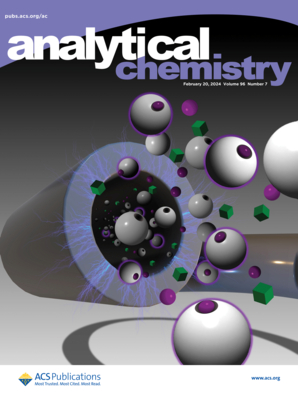Image Fusion for Improving the Spatial Resolution of LA-ICP-MS Imaging.
IF 6.7
1区 化学
Q1 CHEMISTRY, ANALYTICAL
引用次数: 0
Abstract
Laser ablation inductively coupled plasma mass spectrometry (LA-ICP-MS) imaging has been employed to determine elemental distributions in biological tissues and has proven to be valuable for studying nanomaterials used in drug delivery systems. However, in LA-ICP-MS imaging, there are often trade-offs between achieving higher spatial resolution, maintaining sensitivity, and minimizing acquisition time. Using a larger laser spot size retains sensitivity and allows for faster image acquisition, but the resulting poorer resolution is often insufficient for characterizing the distributions of nanomaterials in functional units of organs, such as the kidney, liver, and spleen. In this work, we describe an approach to enhance the spatial resolution of LA-ICP-MS imaging using image fusion through the computational integration of LA-ICP-MS and optical microscopy images. This approach maintains the highly precise and sensitive elemental distributions inherent to LA-ICP-MS while leveraging the high spatial resolution of optical microscopy to obtain more detailed suborgan maps for both biological metals and nanomaterials. Our approaches enable the construction of LA-ICP-MS images with 5 μm resolution without changes to hardware, operational time, or sensitivity. The resulting enhanced resolution yields new insights into nanomaterial excretion through the liver and the role of the immune system in recognizing gold nanoparticles in the spleen. This fusion approach promises to serve as a valuable tool for advancing nanomaterial-based drug delivery systems.提高LA-ICP-MS成像空间分辨率的图像融合。
激光烧蚀电感耦合等离子体质谱(LA-ICP-MS)成像已被用于确定生物组织中的元素分布,并已被证明对研究用于药物输送系统的纳米材料有价值。然而,在LA-ICP-MS成像中,通常需要在实现更高的空间分辨率、保持灵敏度和最小化采集时间之间进行权衡。使用更大的激光光斑尺寸可以保持灵敏度,并允许更快的图像采集,但由此产生的较差的分辨率通常不足以表征器官功能单位(如肾、肝和脾)中纳米材料的分布。在这项工作中,我们描述了一种通过计算集成LA-ICP-MS和光学显微镜图像,利用图像融合来提高LA-ICP-MS成像空间分辨率的方法。这种方法保持了LA-ICP-MS固有的高度精确和敏感的元素分布,同时利用光学显微镜的高空间分辨率获得更详细的生物金属和纳米材料的亚器官图。我们的方法能够构建分辨率为5 μm的LA-ICP-MS图像,而无需改变硬件,操作时间或灵敏度。由此产生的增强分辨率为纳米材料通过肝脏排泄和免疫系统在识别脾脏中金纳米颗粒中的作用提供了新的见解。这种融合方法有望作为一种有价值的工具,用于推进基于纳米材料的药物输送系统。
本文章由计算机程序翻译,如有差异,请以英文原文为准。
求助全文
约1分钟内获得全文
求助全文
来源期刊

Analytical Chemistry
化学-分析化学
CiteScore
12.10
自引率
12.20%
发文量
1949
审稿时长
1.4 months
期刊介绍:
Analytical Chemistry, a peer-reviewed research journal, focuses on disseminating new and original knowledge across all branches of analytical chemistry. Fundamental articles may explore general principles of chemical measurement science and need not directly address existing or potential analytical methodology. They can be entirely theoretical or report experimental results. Contributions may cover various phases of analytical operations, including sampling, bioanalysis, electrochemistry, mass spectrometry, microscale and nanoscale systems, environmental analysis, separations, spectroscopy, chemical reactions and selectivity, instrumentation, imaging, surface analysis, and data processing. Papers discussing known analytical methods should present a significant, original application of the method, a notable improvement, or results on an important analyte.
 求助内容:
求助内容: 应助结果提醒方式:
应助结果提醒方式:


